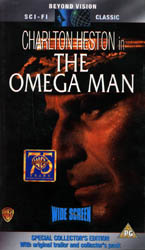Jason Maloney reviews 
Warner Bros.
- Cert:

- Cat.no: S 012654
- Running time: 94 minutes
- Year: 1971
- Pressing: 1995
- Widescreen: 2.35:1
- Price: £12.99

Director:
- Boris Sagal
Cast:
- Neville: Charlton Heston
Matthias: Anthony Zerbe
Lisa: Rosalind Cash
Dutch: Paul Koslo
Zachary: Lincoln Kilpatrick
Richie: Eric Laneuville
Adapted from the classic Richard Mattheson novel “I Am Legend”, The Omega Man is nevertheless a product of its own era. It arrived the very same year as another seminal science-fiction film, Silent Running.
Despite sharing certain stylistic traits and subject matter, if any two films were different sides of the same coin, then The Omega Man and Silent Running would be the prime example. For while the former dealt with the preservation of the ecological and evolutionary status quo in the aftermath of armageddon, the latter takes a very similar scenario but the battle is against the survivors who seek to purge the post apocolyptic world of all that they believe caused its downfall.
The end of the world as we know it, at the hands of burgeoning nuclear and chemical warfare, was a recurring theme in science fiction of the period. The second Planet Of The Apes film, made in 1968, introduced a horrendously scarred community of underground surivivors, mutated by radiation from an atom bomb. The Omega Man – also, intriguingly, starring the unerringly heroic Charlton Heston – takes place in a near-future (1977, 6 years hence from the time of its release) blighted by germ warfare of the most calamitous nature.
However, in keeping with the canny, understated narrative style of the times, the film does not spell out all this information at the beginning. It’s nigh on impossible to conceive of any current movie which would refrain from hitting the audience near senseless with the chilling details of what’s happened and how it all ended up that way. The Omega Man chooses to introduce the pieces of the puzzle slowly, with the aid of well-timed flashbacks, made all the more effective because of their timing.
In its opening sequence, Heston is seen crusing around a sunny American city (could be New York, could be L.A.) in a convertible, to the strains of his 8-track car stereo. At this point, it’s unclear just what is going on. A glimpse of the less-than-idyllic truth is first revealed with a sudden, jarring explosion of gunfire, the burning of rubber on tarmac. This could still be a cop movie, though, for all we know… but hold on – where exactly *is* everyone?
There’s an eeire quality to these early deserted urban landscapes which draws you in, leaves you desperate to find out what on earth (quite literally) has happened. The audience is hooked, with nary a line of dialogue spoken nor any great song and dance required.
Why are the streets, shops and buildings completely empty? Why is this man apparently the only one about, tearing around in any car he chooses from vacated showrooms, pulling up at the movie theatre which is still showing the same film it did 5 years ago? More to the point, why does he need to carry a machine gun?
All these questions are answered, of course, and very satisfyingly so. The revelations concerning Heston’s background, and how he came to avoid the fate of his fellow humans, is handled intelligently and provides the impetus for the second half of the film.
There’s an ambiguity throughout much of the story, as his character’s nemeses seek to undermine the assumptions to be drawn from what we are intially told and shown. To quote a line from late in the movie, “who is right and who is wrong?”. Is this man (Heston) merely playing God, pathetically holding onto the ill-fated past by fashioning a solitary, fantasy lifestyle while all around him is either dead or diseased? Or are his intentions and actions noble and with the future of the Human Race at heart? Is he even alone, for that matter?
Like its cinematic soulmate Silent Running, it never shies away from thought-provoking commentary and cases its hopeful, humanitarian resolutions in an often bitter coating. The Omega Man tackles the big issues of its generation, and of all generations, with a style that ensures itself a place in sci-fi movie history.
Released in 1995 as part of Warner Brothers’ “Beyond Vsion” Sci-Fi Classic series, this edition comes replete with collector’s cards providing some useful background information. The original theatrical trailer is also featured on the tape. Picture quality is excellent, the widescreen print most effective during the early deserted city scenes.
The soundtrack, while obviously not in the Digital Surround league, has few of the niggly hissing defects which films of this vintage are sometimes revealed to have through playback on modern equipment. The score itself is not too shrill, either.
All in all, an essential video for any movie fan’s collection.
PICTURE QUALITY
SOUND QUALITY













 OVERALL
OVERALL 




Check out Jason’s homepage: The Slipstream.
Reviewer of movies, videogames and music since 1994. Aortic valve operation survivor from the same year. Running DVDfever.co.uk since 2000. Nobel Peace Prize winner 2021.
